
Culture Report: Delphinium Delgenius Series
More than 10 years ago, breeder Bart Noordhuis, breeder of echibeckia Summerina and hellebore Frostkiss, asked several growers what crops they struggle with as he wanted to breed plants that needed improvement. One of the crops growers said they really had issues with was delphinium, and this is how the delphinium Delgenius series breeding project was born. The goal was to breed a series that would solve all the problems growers have with delphinium currently on the market, including production of only one flower stem, losing lower foliage and plants growing too tall, thereby needing significant PGR applications.
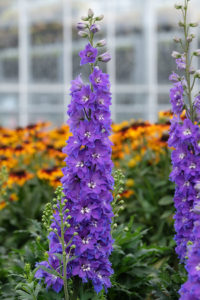
The blood lines crossed to create the Delgenius series bring enormous hardiness, heat tolerance and strong flower stems to delphinium. These will easily fill large pots with only one liner and produce a multi- branching habit in a short amount of time. Not only are Delgenius pot-filling, but they also require no vernalization so crops can be potted in the fall or spring.
The flower power of Delgenius is huge, having multiple, semi-double blooms with rebloom. Even when Delgenius flower, the leaves do not disappear or drop off like many other delphinium on the market but instead stay on the plant, making the display extra attractive. There is no need to use PGRs on these either, as they are genetically compact and bushy, so they do not send up single tall spikes like other varieties. This helps growers save on the costs of application and labor hours.
GROWER QUICK TIPS
Short on time? Here are some quick tips to get you started on the path to the best delphinium Delgenius crop possible.
The delphinium Delgenius program at Pacific Plug & Liner (PP&L) is offered in a 72-cell liner size from tissue culture. Due to their fast and strong growth, we recommend larger pot sizes between 1.5 and 3 gallon, only one liner per pot is needed.
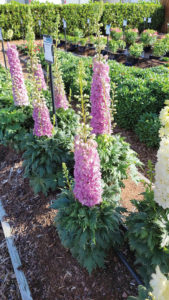
Delgenius need a higher phosphorus rate compared to most perennials; phosphorus is important for producing side shoots and more blooms. The best ratio of P to K for growing Delgenius is 1:2 to 1:2.5.
Delgenius should be grown at a pH between 5.4 and 5.5 and never above 6.0. A high pH will make phosphorus less available, meaning less side shoots and production of a single bloom versus the multiple blooms Delgenius is capable of.
It takes approximately 10 to 16 weeks to get a finished plant after spring planting, depending on climate and pot size. The best spring planting time is April to May for summer flowering. Liners can also be planted August to October and overwintered for an early spring flowering crop.
Delgenius are heavy feeders; use a liquid feed on top of a slow-release fertilizer. EC levels should be kept at 1.5; it is important to keep a watch on the fertilizer level in the soil when the flower stems and buds start to appear. If levels are lower than 1.5, plants need additional fertilizer at that point.
Delgenius are fast-growing plants, therefore they need spacing for the best quality finish. Plants can be spaced after planting to their final spacing or wait till buds start to appear but no later.
Need more details? Below are the specifics to some of the Grower Quick Tips list, plus a lot more.
FERTILIZATION & IRRIGATION GUIDELINES
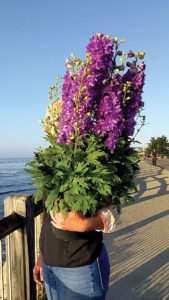
Place the pots outside in an area with full sun and that is well-drained, so plants do not sit in standing water.
Delgenius should have deep green foliage; a lighter color means there is an incorrect balance in fertilizer or that it is too low in fertilizer. When the plants are low in fertilizer for a long period of time, they will lose their lower leaves. If fertilizer levels are too high, the edges of the leaves will scorch.
Delgenius are strong and fast-growing plants, thus they require quite a lot of fertilizer. A base start of slow-release fertilizer is recommended as well as a continuous liquid feed. The recommended EC level in the soil is around 1.5 EC, measured with a 1.5 to 1 method. For those using the AM measuring method, we advise an AM between 0.35 and 0.45 in the soil.
The best ratio between P and K is between 1:2 and 1:2.5. This requires a liquid feeding on top of the base slow release fertilizer (which is mostly P:K 1:3 or 1:4) of 20-20-20 or 27-15-12 with microelements.
Like most plants, it is best to water Delphinium crops early in the day so the foliage has time to dry before going into the night. This will help to prevent diseases.
PLANTING
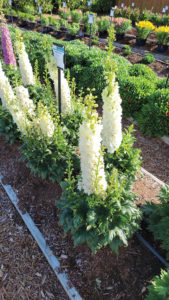
Delgenius will be delivered as a rooted 72-cell liner, ready for planting. Make sure pots are filled to the top with soil to prevent shrinking and plant the liner at the same depth as the soil level, not deeper.
Use a very open peat mix or very good quality bark/ peat mix that is well-drained and has a pH of 5.4 to 5.5. Pure bark is not recommended because the bark is typically poorly decomposed and will absorb much of the available nitrogen from the soil. Delgenius are sensitive to low nitrogen levels in the soil. To help overcome this, we advise the use of a base slow-release fertilizer in the soil to make sure there is always enough fertilizer available. On the side, use liquid fertilizers to top up.
SPACING
For a 1.5-gallon pot, use 4-inch spacing between the pots and for a 2- or 3-gallon pot, use 5-inch spacing between the pots. This can be done at time of planting or as soon as first buds appear but no later.
pH
pH is very important for Delgenius. A pH above 6 slows down the uptake of phosphates and makes the uptake of potassium easy for the plant. Phosphates are necessary for the initiation of side shoots on a plant and also for creating extra flower stems. Potassium makes the cell structure strong and initiates flowers but does not help develop side shoots, so high pH can result in plants with just one flower stem.
PINCHING & PGRS
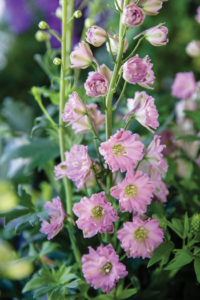
Delgenius will make side shoots naturally, so pinching is not necessary and not needed after planting. Plants can be pinched once flowering if crop delay is needed. No PGR is needed for Delgenius nor is suggested. Delgenius are naturally bushy and multi-branching and tend to be more compact early in production compared to other varieties on the market. If growers feel PGR is needed, start at low doses to test, much lower than traditional delphinium, otherwise plants can be stunted.
Every situation can be different with so many climates, different growing operations and other variables here in the U.S. Please do not hesitate to contact us at PP&L with any questions so we can help you grow the best delphinium Delgenius crop possible.








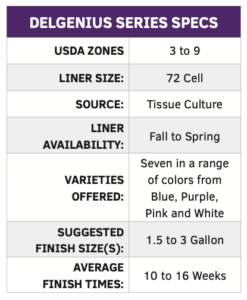
 Video Library
Video Library 

















